
The green and smart energy sector is a significant industry impacting how we produce, store, and use energy. This includes photovoltaic panels, modern batteries, Internet of Things solutions, and energy management platforms. Each solution aims to bring us closer to independence from fossil fuels, prompting startups to seek increasingly innovative ideas. However, technology alone is not enough!
Often, product design plays a crucial role in influencing users. Therefore, manufacturers must take a holistic approach – from the materials and processes used in production to user experiences. By combining various strategies, innovators are setting new standards for what it means to be both technologically advanced and environmentally responsible.
Key Strategies in Sustainable Product Design
In sustainable product design, it’s essential to consider the environmental life cycle assessment (Life Cycle Analysis), which highlights crucial processes to consider – materials (their type, origin), processing and product manufacturing, distribution, use, and end of life.
The choice of materials plays a key role in sustainable design. Manufacturers can opt for lightweight (reducing product weight), biodegradable (easing end-of-life), or recycled materials (reusing resources). For example, packaging made from mycelium instead of styrofoam, produced by GROWN bio (mentioned in the November issue of Start-up of the Month by Innovatika.
After selecting materials, their origin becomes crucial. A responsible supply chain aims to analyze processes to shorten the chain and thereby reduce the carbon footprint.
The amount of material used also matters. Sometimes, a minor change in design can save vast amounts of resources, but functionality must be maintained. Digitalization can be helpful, replacing analog functions with software. A great example is Elliptic labs, which eliminates the need for additional physical sensors by using software (learn more here).
It’s important to remember that a functional, valuable product should serve the user as long as possible. In product design, it’s worth ensuring that products are not only durable but also repairable, upgradeable, and customizable. This extends the product’s lifespan and fosters customer loyalty.
When the user finishes using an item, its end of life must be considered. Circular design principles emphasize recyclability to reduce overall material and energy consumption.
UX/UI: The Human Element in Product Development
The role of UX/UI design in the green and smart energy industry is crucial – creating aesthetic, inclusive, intuitive, and user-friendly interfaces and products. These designs not only engage users but also promote energy-efficient behavior. Ethical design practices should be used, avoiding misleading patterns – known as dark patterns – which are design elements used to deceive or manipulate users into making choices against their interest. While such patterns may temporarily increase engagement or sales, they can easily undermine user trust and long-term brand relationships.
A human-centered approach, encompassing user research, prototyping, and validation, ensures that products are well-tailored to user needs. Ethical, inclusive, attractive, and user-friendly product designs not only encourage purchases but also promote long-term use, strengthening the brand’s position.
Industry Inspirations
Responsible material selection characterizes BeFC. They produce small batteries made from organic materials that do not pose a risk of leaking toxic substances when disposed of.
Saule Technologies patented a new process for manufacturing photovoltaic panels, allowing for cell printing. This can reduce the carbon footprint by up to 20 times. Ease of production, aesthetic appearance, and application simplicity increase their potential use.
We often discard batteries or accumulators that start to perform poorly. Circu Li-ion then steps in. Their solution allows for repairing damaged individual cells in a battery, reducing waste and carbon footprint.
To utilize valuable materials in batteries, Cylib focuses on battery end-of-life, recycling them. Their method enables the recovery of up to 100% of the used Lithium.
Epishine exemplifies good design and utility, extending product usage time. Epishine integrates photovoltaic technology with small electronics. Their solution uses room light to power devices, such as computer keyboards.
Google Nest Thermostat uses machine learning to optimize energy consumption and temperature regulation according to user needs, while maintaining an attractive appearance. The thermostat can be operated using a wall panel or an intuitive app.
See more Examples in our December issue of Startup of the Month.
Conclusion
New products, innovative solutions, and UX design are changing the approach to production and device use. The future of green energy lies in continuous innovation and exploring new possibilities. Companies, adhering to responsible design principles and ethics, can not only change the world for the better, but also gain customer loyalty and strengthen their market position.







